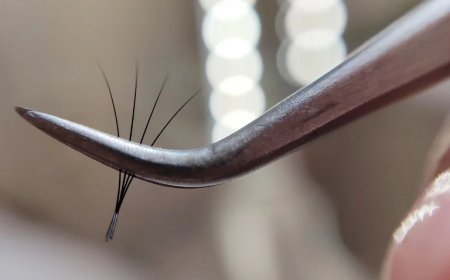How to Clean Silver at Home Without Damaging the Surface
Learn how to clean silver at home without damaging the surface using safe, effective methods. Protect your jewelry, utensils, and decor with expert cleaning tips.
Silver is a timeless and elegant metal, often used in jewelry, cutlery, home dcor, and heirlooms. However, over time, silver naturally tarnishes due to exposure to air and moisture. While cleaning it may seem straightforward, using the wrong methods can cause scratches, discoloration, or permanent damage. This guide will show you how to clean silver at home safely and effectively, ensuring your valuable items maintain their original luster without risk.
Why Does Silver Tarnish?
Before learning how to clean silver at home, it's helpful to understand why it tarnishes. Tarnish is the result of a chemical reaction between silver and sulfur-containing substances in the air. This reaction produces silver sulfide, which appears as a dull, black coating.
Common tarnish causes include:
-
Humidity
-
Air pollution
-
Skin oils and sweat
-
Certain foods (eggs, onions, garlic)
-
Rubber bands and some cleaning agents
Knowing the source helps in choosing the right cleaning method that removes tarnish while protecting the surface.
Important Tips Before You Clean Silver at Home
Not all silver items are created equal. Sterling silver (92.5% silver) is more durable than fine silver (99.9%), and silver-plated items require extra care. Always follow these best practices before cleaning:
-
Inspect the item for cracks, loose stones, or flaking plating.
-
Test a small area first with your chosen method.
-
Avoid abrasive materials such as steel wool or rough sponges.
-
Use lint-free, non-scratch cloths for drying and polishing.
Now, lets look at the safest and most effective ways to clean silver at home.
Method 1: Mild Soap and Warm Water
This is the gentlest and safest method for lightly tarnished silver, especially for jewelry or items with delicate detailing.
What You Need:
-
Mild dish soap (without ammonia or bleach)
-
Warm water
-
Soft cloth or microfiber towel
-
Soft-bristled toothbrush (optional)
Steps:
-
Mix a few drops of dish soap into a bowl of warm water.
-
Dip the silver item in the solution and let it soak for 25 minutes.
-
Use your fingers or a soft brush to gently clean any crevices.
-
Rinse under clean lukewarm water.
-
Dry thoroughly with a lint-free cloth.
Best for: Everyday silver jewelry, light tarnish, and plated items.
Method 2: Baking Soda and Aluminum Foil
This popular DIY technique uses a natural chemical reaction to remove tarnish without scrubbing. Its highly effective for flatware and moderately tarnished items.
What You Need:
-
Baking soda
-
Boiling water
-
Aluminum foil
-
Glass or ceramic bowl
-
Soft cloth
Steps:
-
Line the bottom of a bowl with aluminum foil, shiny side up.
-
Place your silver items on the foil.
-
Sprinkle 24 tablespoons of baking soda evenly over the items.
-
Pour boiling water over everything, enough to submerge the items.
-
Let them sit for 510 minutes.
-
Carefully remove and rinse with warm water.
-
Dry and polish with a soft cloth.
Best for: Heavily tarnished silverware, coins, and decor.
Note: Avoid this method on silver with glued parts or intricate stones.
Method 3: White Vinegar and Baking Soda
For tougher tarnish on jewelry or decor, this mixture offers deep cleaning while being gentle on surfaces.
What You Need:
-
cup white vinegar
-
2 tablespoons baking soda
-
Glass bowl
-
Soft cloth
Steps:
-
Combine vinegar and baking soda in a bowl (it will fizz).
-
Submerge the silver item in the solution for 23 hours.
-
Rinse under cool water.
-
Dry and buff with a soft cloth.
Best for: Deep tarnish on silver jewelry or intricate pieces.
Method 4: Toothpaste (Non-Gel, Non-Whitening)
Regular toothpaste can act as a gentle polish, but only when used correctly.
What You Need:
-
White, non-gel toothpaste
-
Soft toothbrush or cloth
-
Lukewarm water
Steps:
-
Apply a small amount of toothpaste to the item.
-
Gently rub with a soft cloth or brush in a circular motion.
-
Rinse thoroughly under warm water.
-
Dry with a soft towel.
Best for: Touch-ups on rings, earrings, and small objects.
Caution: Avoid abrasive toothpaste formulas that can scratch silver.
Method 5: Commercial Silver Polishes (Used Properly)
If you prefer store-bought products, choose a reputable silver polish designed for fine metals.
What You Need:
-
Silver polish
-
Microfiber cloth
-
Gloves (optional)
Steps:
-
Apply a small amount of polish to a clean cloth.
-
Rub the silver in long, even strokes.
-
Buff with another clean, dry cloth.
Best for: Antiques, heirlooms, or fine silver you want to maintain carefully.
Avoid: Over-polishing, which can wear down silver plating or soft details.
How to Clean Silver Chains and Fine Jewelry
Chains and intricate silver jewelry require special care to avoid tangling or damage.
Recommended Approach:
-
Use the mild soap and warm water method.
-
For deeper cleaning, try a silver-specific jewelry cleaner with a dipping basket.
-
Use a soft jewelry brush to reach between links.
-
Always pat drynever rub aggressively.
How to Clean Silver Cutlery and Utensils
Silver flatware requires frequent cleaning, especially if used regularly.
Cleaning Tips:
-
Use baking soda and aluminum foil for sets.
-
Wash with mild soap and water after every use.
-
Dry immediately to prevent water spots and tarnish.
-
Store in anti-tarnish cloth or lined silverware boxes.
Avoid dishwashers, as heat and detergents can erode the silver coating.
How to Store Silver to Prevent Tarnish
Prevention is just as important as cleaning when it comes to silver care.
Storage Tips:
-
Keep silver dry and store it in a cool, low-humidity area.
-
Use anti-tarnish strips or cloth pouches.
-
Store items separately to prevent scratching.
-
Avoid plastic bags, as they can trap moisture and chemicals.
-
Wear silver jewelry regularlythe oils from your skin can actually help prevent tarnish.
Common Mistakes to Avoid When Cleaning Silver at Home
Learning how to clean silver at home without damaging the surface also involves avoiding common errors:
-
Using harsh chemicals: Bleach, ammonia, and chlorine can ruin silver.
-
Over-polishing: Removes the protective layer and thins silver plating.
-
Using rough cloths: These cause scratches, especially on polished finishes.
-
Skipping drying: Water spots can lead to faster tarnishing.
-
Ignoring regular maintenance: Letting tarnish build up makes cleaning harder and riskier.
Frequency: How Often Should You Clean Silver?
How often you clean silver depends on how often its used or exposed.
-
Everyday wear jewelry: Light cleaning every 12 weeks
-
Occasional use items: Clean monthly or before/after use
-
Stored silver: Check every 23 months and wipe with a soft cloth
Read also: Crafting Personal Wealth Strategies for Financial Freedom
Conclusion: Keep Your Silver Looking Brilliant with Safe Home Techniques
Now that you know how to clean silver at home without damaging the surface, you can keep your silver items looking beautiful for years to come. Whether youre preserving family heirlooms, everyday jewelry, or stylish home dcor, using the right cleaning method ensures your silver stays shiny and protected.
Choose the technique that matches your silvers level of tarnish, handle items with care, and commit to proper storage and regular maintenance. With a little effort and the right knowledge, your silver will always shine.








































